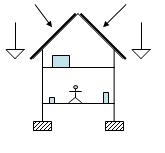Structural load facts for kids
Structural loads are the forces, changes in shape, or movements that act on a building, bridge, or any other structure, or on its parts. Think of a load as the amount of weight a structure needs to hold up. These loads can cause stress, changes in shape, and movement within the structure.
Engineers use something called Structural analysis to figure out how these loads will affect a structure. If a structure has too much load, it might break or fail. This is why engineers carefully plan and build structures to make sure they are strong enough to handle all the loads they will face.
Different kinds of structures, like airplanes, satellites, rockets, ships, and submarines, all have their own special types of structural loads. For example, in trucks, the main frame (called the chassis) is built to carry the weight. In many cars, the outer metal skin is designed to carry the load, which is known as "unibody" construction.
One common load is from Gravity on Earth. Gravity is the force that pulls all objects downwards. So, a gravity load is simply the downward pull of gravity on a structure and everything in it.
Contents
What are the Main Types of Structural Loads?
Engineers consider several common types of loads when designing most structures:
Dead Loads: The Permanent Weight
- A dead load is the weight that is always on a structure. This includes the weight of the structure itself, like the walls, roof, and floors. It's a permanent weight that doesn't change. For example, the concrete in a building or the steel in a bridge are part of the dead load.
Live Loads: The Moving Weight
- A live load is anything a structure is designed to carry that can move or change. These loads are not permanent. They can be in different parts of the structure at different times. For example, in a building, people, furniture, and equipment are live loads. In a vehicle, passengers and luggage are live loads. Snow on a roof is also a live load because it can melt or drift.
Wind Loads: The Force of Air
- A wind load is the force of wind pushing against the outside of a structure. Wind loads are horizontal forces, meaning they push sideways. They are very important for tall buildings, as strong winds can create a lot of pressure. Sometimes, wind can even cause an "uplift" force, which might try to lift a roof upwards!
Snow Loads: The Weight of Snow
- A snow load is the weight of snow on a structure, especially on a roof. Like live loads, snow loads are not permanent. Snow can melt, or wind can blow it around, causing it to pile up in certain areas of a roof. This means the weight can shift.
Other Important Environmental Loads
Besides the main types, structures can also be affected by other forces from their environment:
- Earthquake loads: Forces from ground shaking during an earthquake.
- Temperature changes: When materials get hot, they expand, and when they get cold, they shrink. This can create forces called thermal loads.
- Ponding loads: The weight of water that collects on a flat roof.
- Frost heaving: When water in the soil freezes and expands, pushing up parts of a structure.
- Pressure from soil: The sideways push of soil against underground walls or foundations.
- Loads from water: Forces from floods or water in tanks.
- Permafrost melting: If frozen ground (permafrost) melts, it can cause the ground under a structure to become unstable.
Aircraft Structural Loads
For airplanes, structural loads are divided into two main groups:
- Limit loads are the highest loads an airplane part or structure can safely handle without getting damaged.
- Ultimate loads are even higher. They are 1.5 times the limit loads. If an airplane experiences ultimate loads, it might break or fail.
Engineers also consider:
- Gust loads: These are sudden forces from strong wind gusts.
- Crash loads: These are the forces an aircraft experiences during a hard landing or impact.
- Pressure loads: For planes that fly very high, the difference in air pressure inside and outside the plane creates pressure loads.
- Ground loads: These are forces on the plane when it's on the ground, like from braking hard or turning while taxiing.
Airplanes are always going through different loads during flight. These repeated loads can cause the materials to get tired over time, which is called metal fatigue.
See also
 In Spanish: Carga estructural para niños
In Spanish: Carga estructural para niños



